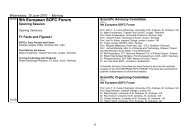European Fuel Cell Forum 2011
European Fuel Cell Forum 2011
European Fuel Cell Forum 2011
You also want an ePaper? Increase the reach of your titles
YUMPU automatically turns print PDFs into web optimized ePapers that Google loves.
�<br />
�<br />
<strong>European</strong> <strong>Fuel</strong> <strong>Cell</strong> <strong>Forum</strong> <strong>2011</strong> 28 June -1 July <strong>2011</strong>, Lucerne Switzerland<br />
A0706<br />
Effect of oxide formation on the oxygen reduction<br />
kinetics on Pt and PtCo PEMFC cathodes<br />
Max Cimenti, Robert Kehoe, and Jürgen Stumper<br />
Automotive <strong>Fuel</strong> <strong>Cell</strong> Cooperation Corporation<br />
Research & Development<br />
9000 Glenlyon Parkway<br />
Burnaby, BC V5J 5J8, Canada<br />
Tel.: +1-778-331-3222<br />
Fax: +1-604-7291<br />
max.cimenti@afcc-auto.com<br />
Abstract<br />
Understanding the impact of platinum oxide (PtOx) on the oxygen reduction (ORR) kinetics<br />
of proton-exchange membrane fuel cell cathodes is relevant to improve fuel cell<br />
performance.<br />
The ORR kinetics was investigated as a function of PtOx coverage. PtOx coverage was<br />
determined by cyclic voltammetry, while to measure the ORR kinetics at constant PtOx<br />
coverage a procedure based on fast transient polarization was developed. Electrochemical<br />
impedance spectroscopy was used to measure the ohmic resistance of the MEAs and the<br />
effective proton resistance of the cathode catalyst layer. Tafel analysis was applied to<br />
estimate the kinetics parameters.<br />
Results obtained indicate a dependence of the cathode specific activity and exchange<br />
current density on the conditioning potential (i.e. PtOx coverage). The exchange current<br />
density exhibits a maximum at ~0.85 V for both Pt and PtCo cathodes. The observed<br />
variation in exchange current density and Tafel slope with conditioning potential is more<br />
significant for PtCo cathodes. The trends observed for the ORR kinetic parameters are<br />
consistent with the previously reported “doubling” of the Tafel slope measured at steadystate.<br />
The behavior observed could be related to the presence of different of PtOx surface<br />
species. H2-crossover, and the non-faradic currents related to PtOx reduction were<br />
identified as possible sources of error in the measurement of the PtOx coverage and ORR<br />
kinetics.<br />
PEMFC Components-Electrodes A07 - 6/10<br />
�<br />
�<br />
<strong>European</strong> <strong>Fuel</strong> <strong>Cell</strong> <strong>Forum</strong> <strong>2011</strong> 28 June -1 July <strong>2011</strong>, Lucerne Switzerland<br />
A0707<br />
Integrated Electrodes with Pt Nanowires in Direct<br />
Methanol <strong>Fuel</strong> <strong>Cell</strong>s<br />
Shangfeng Du and Artur Majewski<br />
School of Chemical Engineering<br />
University of Birmingham<br />
Edgbaston, Birmingham B15 2TT, UK<br />
Tel.: +44-121-414-5081<br />
Fax: +44-121-414-5324<br />
s.du@bham.ac.uk<br />
Abstract<br />
Due to one-dimensional features, Pt nanowires can overcome some shortages of<br />
extremely small nanoparticles which suffer from the “particle size effect” and aggregate<br />
readily leading to lower mass activity and efficiency as catalysts in low temperature<br />
polymer electrolyte fuel cells (PEFCs). Several research works have showed that Pt-based<br />
nanowires exhibited a better catalytic capability than supported or un-supported Pt<br />
nanoparticles as catalysts in fuel cells, especially under the high Pt content-loaded<br />
conditions that is typically required for direct methanol fuel cells (DMFCs).<br />
Using formic acid as reducing agent, single-crystal Pt nanowires along the direction<br />
can be prepared from precursor at room temperature, without using any templates, organic<br />
solvents or inducing growth catalysts. With the carbon paper as gas diffusion layer (GDL)<br />
support, single-crystal Pt nanowires, with a length ca. 100–200 nm, were in-situ grown<br />
onto the micro-porous layer surface of GDLs and used directly as integrated gas diffusion<br />
electrodes (GDEs) in DMFCs. This route is much simpler than the conventional method for<br />
preparing GDEs because there were no processes needed to make the ink or print the<br />
catalysis layer.<br />
In this work, membrane electrode assemblies (MEAs) were manufactured with the asprepared<br />
Pt-nanowire GDEs and test as cathodes in a 5 cm 2 DMFC in comparison with a<br />
commercial cathode. Full cell and cathode polarization measurement and cathode cyclic<br />
voltammetry were performed to evaluate the as-prepared GDEs. A life-test was also<br />
undertaken to investigate the GDE durability by voltage ramp repeated in 3000 loops. The<br />
results showed that the Pt nanowire GDEs possessed a higher catalytic performance and<br />
a better durability, but a lower electrochemical surface area than did the commercial<br />
products.<br />
PEMFC Components-Electrodes A07 - 7/10




